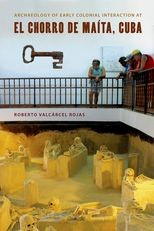Archaeology of Early Colonial Interaction at El Chorro de Maíta, Cuba
Archaeology of Early Colonial Interaction at El Chorro de Maíta, Cuba
Cite
Abstract
Archaeology of Early Colonial Interaction at El Chorro de Maíta, Cuba, examines the interactions between indigenous peoples and European invaders in the Caribbean and the way in which domination imposed by a foreign model ultimately transformed this relationship into a system of colonial subordination. Investigations of the domestic and funerary contexts at the El Chorro de Maíta, in the northeast of Cuba, permit the archaeological visualization of the cultural and ethnic diversity imposed by colonial domination. Presented, for the first time, is the identification and archaeological study of an indigenous village that was transformed during the 16th-century into a town of Indian encomendados, which is to say working for the Spanish as forced labor. The study distinguishes the Christianization of the indigenous inhabitants, principally among those of elite status, and the process of ethnogenesis which gave rise to the “Indian” as a colonial category. This occurred in a scenario where indigenous mortuary practices were maintained, and handled and restricted the Hispanic material culture. It treats the process that created the cemetery with syncretic characteristics, in which there is an adjustment to a process of transculturation where the cultures and the individuals are transformed, and in which the indigenous peoples demonstrated a capacity for resistance and adaptation that is generally underestimated. This book demonstrates the value of archaeology to observe unrecorded episodes of Caribbean and American history that are vital for constructing the link with the pre-Columbian world and the construction of an integrated and new history.
-
Front Matter
-
1
Introduction
-
2
From Contact to the Colonial Situation
-
3
Cuba: The Spanish Colonization
-
4
El Chorro de Maíta: A First Look
-
5
Recognizing the Living Space
-
6
The Cemetery: Death and Human Diversity
-
7
Mortuary Practices in a Colonial Environment
-
8
An Indian Town in Times of the Encomienda
- 9 Summary and Conclusions
-
End Matter
Sign in
Personal account
- Sign in with email/username & password
- Get email alerts
- Save searches
- Purchase content
- Activate your purchase/trial code
Institutional access
-
Sign in through your institution
- Sign in with a library card Sign in with username/password Recommend to your librarian
Institutional account management
Sign in as administratorPurchase
Our books are available by subscription or purchase to libraries and institutions.
Purchasing information| Month: | Total Views: |
|---|---|
| January 2023 | 1 |
| January 2023 | 1 |
| February 2023 | 2 |
| May 2023 | 1 |
| August 2023 | 1 |
| October 2023 | 1 |
| October 2023 | 5 |
| October 2023 | 1 |



Get help with access
Institutional access
Access to content on Oxford Academic is often provided through institutional subscriptions and purchases. If you are a member of an institution with an active account, you may be able to access content in one of the following ways:
IP based access
Typically, access is provided across an institutional network to a range of IP addresses. This authentication occurs automatically, and it is not possible to sign out of an IP authenticated account.
Sign in through your institution
Choose this option to get remote access when outside your institution. Shibboleth/Open Athens technology is used to provide single sign-on between your institution’s website and Oxford Academic.
If your institution is not listed or you cannot sign in to your institution’s website, please contact your librarian or administrator.
Sign in with a library card
Enter your library card number to sign in. If you cannot sign in, please contact your librarian.
Society Members
Society member access to a journal is achieved in one of the following ways:
Sign in through society site
Many societies offer single sign-on between the society website and Oxford Academic. If you see ‘Sign in through society site’ in the sign in pane within a journal:
If you do not have a society account or have forgotten your username or password, please contact your society.
Sign in using a personal account
Some societies use Oxford Academic personal accounts to provide access to their members. See below.
Personal account
A personal account can be used to get email alerts, save searches, purchase content, and activate subscriptions.
Some societies use Oxford Academic personal accounts to provide access to their members.
Viewing your signed in accounts
Click the account icon in the top right to:
Signed in but can't access content
Oxford Academic is home to a wide variety of products. The institutional subscription may not cover the content that you are trying to access. If you believe you should have access to that content, please contact your librarian.
Institutional account management
For librarians and administrators, your personal account also provides access to institutional account management. Here you will find options to view and activate subscriptions, manage institutional settings and access options, access usage statistics, and more.